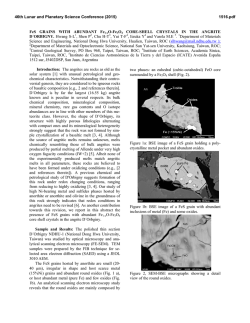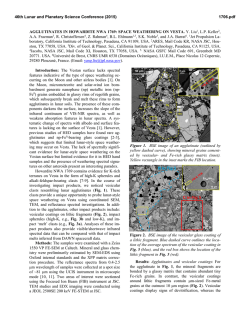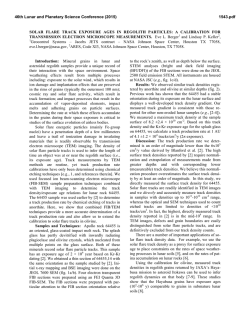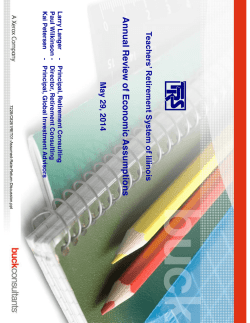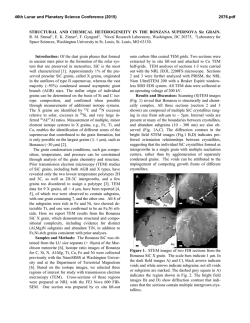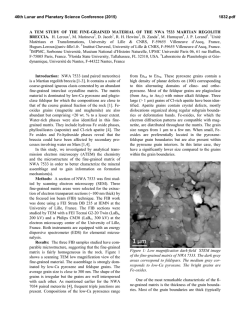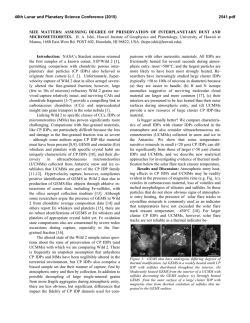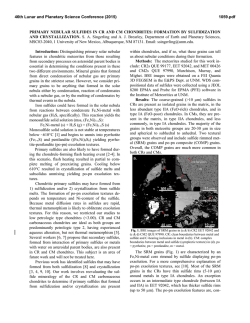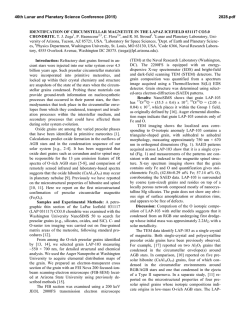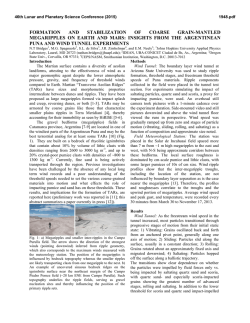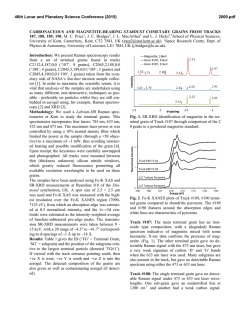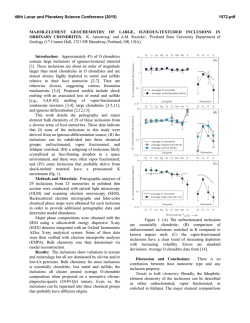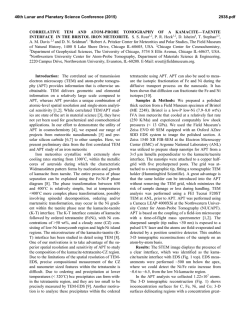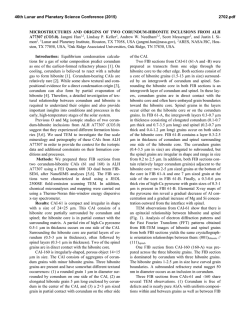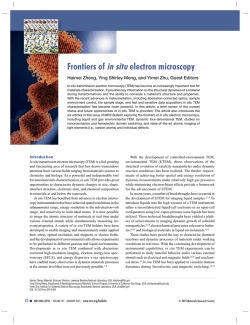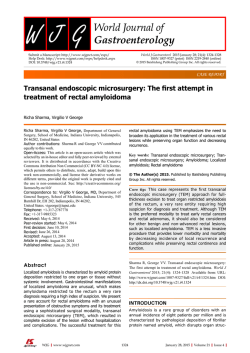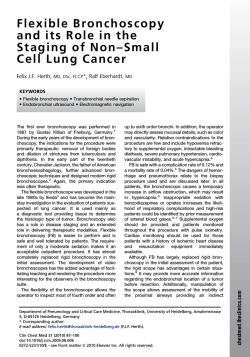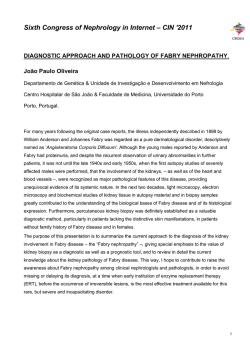
COMPLETE TEM-TOMOGRAPHY: 3D - USRA
46th Lunar and Planetary Science Conference (2015) 2177.pdf COMPLETE TEM-TOMOGRAPHY: 3D STRUCTURE OF GEMS CLUSTER. J. Matsuno1, A. Miyake1, A. Tsuchiyama1, S. Messenger2, and K. Nakamura-Messenger2, 1Dep. of Geology and Mineralogy, Kyoto University, Kitashirakawa, Oiwake-cho, Sakyou-ku, Kyoto, 606-8502, JAPAN ([email protected]), 2Robert M. Walker Laboratory for Space Science, EISD, ARES, NASA Johnson Space Center, Houston TX 77058, USA Introduction: GEMS (glass with embedded metal and sulfide) grains in interplanetary dust particles (IDPs) are considered to be one of the ubiquitous and fundamental building blocks of solids in the Solar System. They have been considered to be interstellar silicate dust that survived various metamorphism or alteration processes in the protoplanetary disk [e.g., 1−3] but the elemental and isotopic composition measurements suggest that most of them have been formed in the protoplanetary disk as condensates from high temperature gas [e.g., 4]. This formation model is also supported by the formation of GEMS-like grains with respect to the size, mineral assemblage, texture and infrared spectrum by condensation experiments from mean GEMS composition materials [5]. Previous GEMS studies [1−4] were performed only with 2D observation by transmission electron microscopy (TEM) or scanning TEM (STEM). However, the 3D shape and structure of GEMS grains [3] and the spatial distribution of Fe/FeS’s [4] has critical information about their formation and origin. Recently, the 3D structure of GEMS grains in ultrathin sections of cluster IDPs was revealed by electron tomography using a TEM/STEM (JEM-2100F, JEOL) [6]. However, CT images of thin sections mounted on Cu grids acquired by conventional TEM-tomography are limited to low tilt angles (e. g., < |75°|). In fact, previous 3D TEM observations of GEMS were affected by some artifacts related to the limited tilt range in the TEM used [6]. Complete tomographic images should be acquired by rotating the sample tilt angle over a range of more than |80|° otherwise the CT images lose their correct structures [7]. In order to constrain the origin and formation process of GEMS grains more clearly, we performed complete electron tomography for GEMS grains. Here we report the sample preparation method we have developed for this study, and the preliminary results. Sample and Methods: In order to obtain transmission images upon tilting at large angles, we processed a rod-shaped specimen fabricated by a focused ion beam (FIB), the details described in [7,8]. The sample was placed on a TEM holder which had been modified by cutting the top of the retainer (Fig. 1). Fine rod-shaped specimens were also prepared for atom-probe tomography (APT) analysis [e. g., 9,10], which makes it possible to obtain 3D distribution of elements in atomic scale. In the preparation, the spec- imen was mounted on the top of a pointed tungsten needle and sharpened the top by an annular FIB [9]. Such rod-shaped samples are also suitable for TEMtomography as well as APT. The present sampling methods to acquire the complete TEM-tomography was applied by using the FIB processes for APT analysis. A potted butt of a cluster IDP (L2036AA10 cluster 4) prepared by an ultramicrotome was used for the present observation. After a short survey of the potted butt by FE-SEM (JSM-7001F, JEOL), a portion composed of fine GEMS grains was excavated by Ga+ ion beam by FIB (Quanta 200 3DS, FEI) and lifted up with a tungsten needle (Fig. 1A). Before the sampling, the surface of the potted butt was covered with platinum deposition to protect it against ion beam damage. Another tungsten needle (0.1−0.2 mm in diameter and ~7.5 mm in length) attached to the bottom of a Cu pipe (2 mm in diameter) was mounted on a FIB stage and Fig 1: Preparation for a rod sample in this study. (A) A target area in a potted butt was pulled out by FIB. The specimen was attached to a W needle. Pt deposition covered the surface to protect from the beam damages. (SEM image) (B) The specimen was mounted on another W needle and trimmed (secondary ion micrographic (SIM) image). (C) A back scattered electron (BSE) image of the sample rod after sharped by Ga+ beam. The top is capped by Pt. 46th Lunar and Planetary Science Conference (2015) the specimen with platinum deposition was remounted on the top of the tungsten needle (Fig. 1B). It was trimmed and sharpened to be rod-shaped by the FIB. The final diameter of the rod is ~400 nm and the length is ~4 µm (Fig. 1C). The rod was put on a single tilting holder with an improved TEM retainer whose top was cut and a V-shaped notch with a groove was fabricated in order to keep the needle on the retainer. The sample was observed by BF-TEM (bright field-TEM) and HAADF-STEM (high angle annular dark fieldscanning TEM) modes using FE-TEM (JEM-2100F, JEOL) at Kyoto University. The spot size of the STEM mode was 0.7 nm, the convergence angle of HAADF mode was 13 mrad, and the acceptable angle was from 35 (inside diameter) to 92 (outside diameter) mrad (HAADF1 condition). Fig 2: (A) A CT image acquired by HAADF-STEMtomography. GEMS grains embedded in epoxy exist as a cluster while the grain boundaries are obscure. White particles correspond to Fe and FeS inclusions. Some GEMS grains have abundant Fe and FeS inclusions (blue arrow) while others seem to have only one inclusion (white arrow). (B) A slice image at yz plane. An iron or iron sulfide has a void-like inclusion (white arrow). 2177.pdf Before performing tomography, 2D elemental mapping was performed to estimate mineral phases by using EDS (energy dispersive X-ray spectroscopy) system (JED-2300T, JEOL) equipped in the TEM/STEM. However, the fine texture could not be obtained due to the thick rod. A series of tilting images was obtained almost completely in the tilting range from -90° to 86.5° in 1° intervals automatically using a software (TEMography, System In Frontier Inc.) by HAADFSTEM mode. The alignment of the rotating axis was performed manually by tracking fine Fe and FeS inclusions as ground control points. The voxel size of acquired slice image is 2.44 nm and the fitting error average of the rotation axis is 0.0698 pixel. CT images were reconstructed by a filtered back-projection method. Results and discussions: A series of slice images were successfully obtained (Fig. 2). Artifacts due to the incomplete tomography, such as tails extending from Fe and FeS inclusions observed in the previous method [6] weren’t detected. However, mismatching of the rotation axis due to the manual alignment caused some image distortion. Many GEMS grains were observed to be aggregated into clusters, as proposed by prior 2D TEM observation [4] (Fig. 2A) although the grain surfaces are too obscure to trace them clearly. Bright particles typically 5−20 nm in size corresponding to Fe and FeS inclusions were observed in each GEMS grain (Fig. 2A). Some of them have voidlike inclusions (Fig. 2B) as observed in the previous report [6]. Some GEMS grains have abundant Fe and FeS inclusions while others seem to have only one inclusion or no inclusions (Fig. 2A) at least within the present spatial resolution. This may reflect that GEMS grains (or the primary grains) formed in various environments and aggregated with each other as the observed cluster. We also emphasized that the present study is the first successful example adapting the complete TEM-tomography to the IDPs. This type of analysis will be also important for planetary material sciences in the future. References: [1] J. P. Bradley et al. (1994) Science. 265, 925–929. [2] J. P. Bradley et al. (1999) Science, 285, 1716–1718. [3] J. P. Bradley and Z. R. Dai (2004) Astrophys. J. 617, 650–655. [4] L. P. Keller and S. Messenger (2011) Geochim. Cosmochim. Acta 75, 5336–5365. [5] Matsuno et al. (2014) Lunar & Planetary Science, 45, #1335 (abstr.). [6] Matsuno et al. (2014) Meteorit. Planet. Sci., 77, A5079 (abstr.). [7] Kawase et al. (2007) Ultramicroscopy 107, 8–15. [8] Miyake et al. (2014) Microscopy, 63, i24–25. [9] Chen et al. (2009) Scr. Mater. 61, 693–696. [10] Valley et al. (2014) Nat. Geosci. 7, 219–223.
© Copyright 2024
